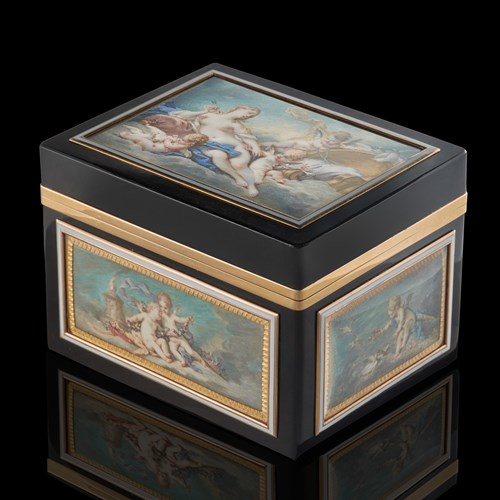Marketplace
Portrait of a gentleman wearing a steel grey coat, with a white waistcoat and jabot with glazed hair reverse
CHARLES SHIRREFF
Portrait of a gentleman wearing a steel grey coat, with a white waistcoat and jabot with glazed hair reverse
The Limner Company : Portrait Miniature
Date Circa 1790
Medium Watercolour on ivory
Dimension 6.7 cm (2⁵/₈ inches)
At the age of four, Charles Shirreff lost his ability to speak and hear. This did not prevent him from developing his artistic skill, which allowed him to enrol at the R.A. schools in 1768, moving away from Scotland, where he was born. Much of his life is recorded in an article by William Foster in the Walpole Society Journal [1]. A decade after his enrollment at the R.A. schools, he had been granted permission to travel to India with his sister and father, however, he would not take up this opportunity until the end of 1795. India was a popular destination for many portrait miniature painters, who felt that they would gain more commissions amongst the British citizens residing there [2].
The sitter of this portrait is unknown. However, a previous dating of the portrait to 1790 suggests that this gentleman was painted during Shirreff’s stay in Bath at the start of this decade, before he travelled to India. The composition of the portrait is rather unusual in comparison to others by Shirreff, especially given that many of his sitters were officers or depicted in military dress. Here, the gentleman sits in front of a draped curtain, and a tree can be seen in the background beyond. The artist’s distinctive use of cross-hatching across the features of the sitter and the background is evident here. This creates a sense of lightness across the miniature, especially in the sitter’s hair and his facial expression, seemingly captured in a brief moment, with his lips slightly apart.
[1] W. Foster, British Artists in India, The Volume of the Walpole Society, vol. 19, pp.67-69.
[2] For example, John Smart (1741-1811), and Diana Hill (1760-1844) also moved there.
The sitter of this portrait is unknown. However, a previous dating of the portrait to 1790 suggests that this gentleman was painted during Shirreff’s stay in Bath at the start of this decade, before he travelled to India. The composition of the portrait is rather unusual in comparison to others by Shirreff, especially given that many of his sitters were officers or depicted in military dress. Here, the gentleman sits in front of a draped curtain, and a tree can be seen in the background beyond. The artist’s distinctive use of cross-hatching across the features of the sitter and the background is evident here. This creates a sense of lightness across the miniature, especially in the sitter’s hair and his facial expression, seemingly captured in a brief moment, with his lips slightly apart.
[1] W. Foster, British Artists in India, The Volume of the Walpole Society, vol. 19, pp.67-69.
[2] For example, John Smart (1741-1811), and Diana Hill (1760-1844) also moved there.
Date: Circa 1790
Medium: Watercolour on ivory
Dimension: 6.7 cm (2⁵/₈ inches)
Provenance: Christie’s, London, 27 March 1979, lot 83;
Sotheby’s, London, 16 April 2008, lot 85;
With Claudia Hill, Ellison Fine Art, 2010;
Private collection, UK.
More artworks from the Gallery




 when Prince of Wales_T638895561060541880.JPG?width=500&height=500&mode=pad&scale=both&qlt=90&format=jpg)

-Portrait miniature of a Lady of the French royal family, possibly Anne of Austria (1601-1666), Queen of France_T638913686204170000.JPG?width=500&height=500&mode=pad&scale=both&qlt=90&format=jpg)
-Portrait miniature of a Young Lady in a blue redingote and yellow waistcoat, with flounced collar and striped cravat_T638964936700169318.jpg?width=500&height=500&mode=pad&scale=both&qlt=90&format=jpg)
, aged 15, wearing a black jacket and white stock_T638737693792178764.JPG?width=500&height=500&mode=pad&scale=both&qlt=90&format=jpg)
_T638865313905788300.JPG?width=500&height=500&mode=pad&scale=both&qlt=90&format=jpg)